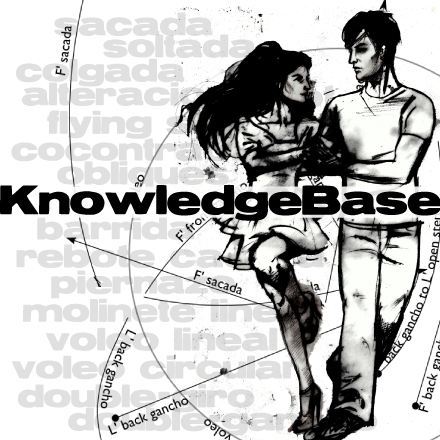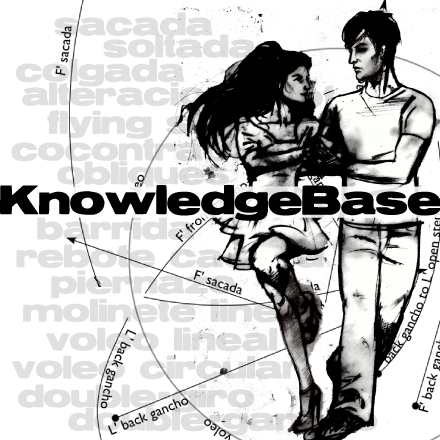To create a movement, we make two sequential operations:
- First, the mark shows intention toward a direction, and the revel prepares her body by [1] adjusting her arc and [2] beginning to extend her free leg in accord. This dual preparation is called projection.
- Second, the movement is completed. If the movement is a step, the mark moves the arch of connection to a new combination of base legs. In this process the transfer of weight is deliberate and creates opportunities to play. If the movement is some kind of special effect, the mark applies co-contraction to put power into the Revel’s free leg.
The Revel does not complete the movement automatically or independently, no matter how sure she is of the Mark’s plans. She holds the projection as long as possible to create space and time for the mark’s creativity.
Revels should not think about stepping, only about projecting.
Marks project too! In front steps and other situations marks may or may not extend their own free leg simultaneously with her projection. But when the mark steps backward, he needs to project, so that he will be able to maintain the arch of connection when he transfers weight.
Procedure for intention/projection
Intention is always the very first part of the next movement. To create intention we prepare our bodies for a new direction and communicate about that with the partner, without going there yet! The relation with the partner, through the arch of connection, helps us to sense and make micro adjustments during this moment. If we lose the arch one of us has moved too soon.
- Both dancers need flexion of the base leg’s hip joint for stability, this also activates the base leg’s muscles.
- The mark controls the amount of knee flexion in the base leg, which determines the size of the step!
- Hip and knee flexions, which prepare and control the step, must happen before the step, not during the motion.
- The mark shows intention by using his body to push or pull against the Revel’s points of connection. He does not use his hands! 2mm movement is plenty, because his is just information, not motion!
- Direction: Toward the Mark: Use hip flexion to pull chest backward, with the result of pulling equally on both of the Revel’s points of connection (both hands, or both sides of her body)
- Direction: Away from the Mark: Use hip flexion to push the chest forward, with the result of pushing equally on the Revel’s points of connection
- Direction: Lateral to the Mark’s body: Contract the corresponding oblique muscles, this creates a small rotation of his body with the result of pulling on one of the Revel’s points of connection
- Both dancers align their base legs into external rotation relative to the direction of intention/projection. They use the oblique muscles of the base leg to rotate the leg and body.
- The revel perceives the information he is directing at her through her points of connection, whichever these may be at any given moment. She constantly adjusts her points of connection (hands, chest, arms) so that she can perceive information from both sides of his body, in all directions. She responds to his intention by intensifying her arc in adjustment to the direction of intention (so that her arc doesn’t move!) and beginning to gently project/extend her her free leg in the direction indicated.
- The revel’s free leg extends toward projection, sliding the toes along the floor with the leg and foot in external rotation. During the projection, the knee and ankle are gradually fully extended. The first thing to move, however, is the free leg’s hip.
- In back projection, the free leg’s hip extends.
- In front projection, the free leg’s hip flexes (also flexing the knee for a moment).
- In side projection, the free leg’s hip abducts. Note that the external rotation in side projection is slight. (The knee faces front.)
- Sometimes the Mark is projecting as well, in which case he maintains his arc’s position as he does so.
- When the free leg is passing close to the base leg, the knee and ankle joint relax, and the hip takes a slight internal rotation (this is the “sexy” aesthetic) of tango. As it reaches further toward projection, the free leg has external rotation and the knee and ankle extend fully.
- A sublime mark will control length, direction, and dynamic of the revel’s projection precisely at all times. A sublime revel expresses his intention exactly, and does not make arbitrary sizes or dynamics.
Alignment for projection
As the first act of projection, the Revel always needs to increase flexion in the hip of her base leg, so that she is strong enough to maintain her arc when she extends her free leg. She uses this flexion to adjust the arc to the direction of the intention, pushing or pulling with her arc on the arch so that she can maintain her current position.
She also needs to align her hips and foot so that
- her hips are perpendicular to the direction of the mark’s intention
- her base leg (and foot) is in external rotation relative to the direction of the intention
Front step
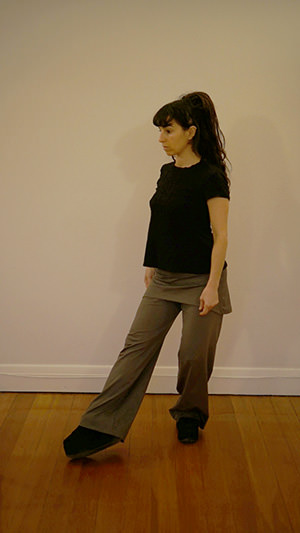

Back step
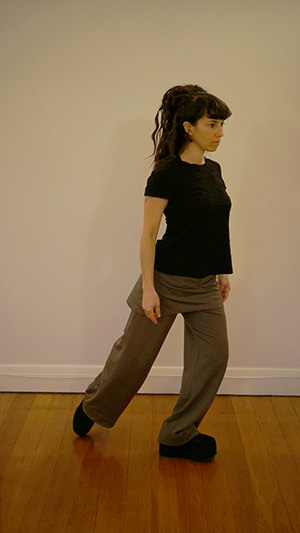

Side step
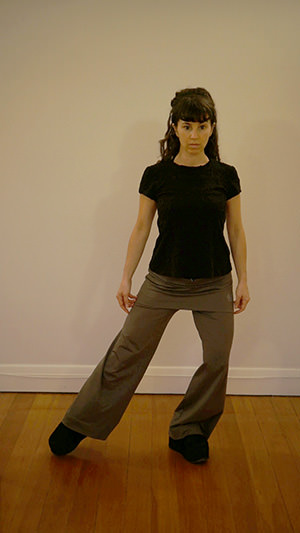

Now she’s ready to extend her free leg in the direction of intention.
The free leg in the three directions of projection
Each projection starts with the free leg’s hip joint, extending into back projection, flexing for front projection, abducting for side projection.
The free leg’s knee should reach full extension during projection so that it has a beautiful length in every movement.
During projection toward side step, the inside of the free leg’s big toe stays in contact with the floor, the knee and ankle gradually extending. As the transfer of weight begins, the free leg’s little toes should stretch toward the floor to activate the leg muscles to start establishing the new base. Note that in side projection, the external rotation is slight.
During projection toward back step, extension of hip joint, starting at the top of the psoas muscle. The inside of the big toe slides along the floor, again the ankle and knee gradually extending. In back ocho the revel needs to exercise extreme caution not to allow the toe to lose contact with the floor. It is more common to have problems with extending the left foot because of the torsion of the body constrained by the embrace. Especially in back ocho with the left foot, many revels lose contact with the floor for an instant at the end of the projection, causing an ugly and dysfunctional foot position as they begin the transfer of weight. The solution to most problems with back steps and back ochos is to increase the old base leg’s hip flexion during transfer and the hip flexion of the new base leg as it begins receiving weight.
Projection toward front step is the most stylized as here the relaxation of ankle and knee offer the most possibilities for drama. In the front step, the knee flexes along with the hip (without changing the shape and strength of the base leg’s arc!), dragging the ankle and foot which eventually consent to unfurl. Here the blasé attitude of the revel is most performative. In the final maximum projection position of front extension with the foot pointed, the inside of the big toe is no longer closest to the floor. Instead the little toes will be closest to the floor. Once the revel starts to step front, the free leg’s ankle flexes to place the heel down first (unless it is a very tiny step, in which case the revel can transfer weight toe-first).
The limit of the reach of the extension is defined by your arc and the amount of flexion the Mark has put in your base leg’s knee. Do not reach your toes so far away from your body that you must break your arc.
Second projection
Normal steps have two projections, one at the beginning, and the second one at the end of the step. Once the old base leg has fully extended, it will be free of weight, it will become the new free leg and it will extend toward its former position. This is the second projection.
The newly-freed old base leg should not promptly join the new base leg (“collect”, deprecated). It’s now free, which means [1] it now belongs to the mark so it must be available to him and not doing anything arbitrary and [2] it should be beautiful, with knee and ankle extended and toes pointed toward its former position. When the free leg is extending in this second projection, it creates spaciousness for the mark to create.
The second projection is crucial for cross, rebote, parada, voleo, and lots of other special effects.
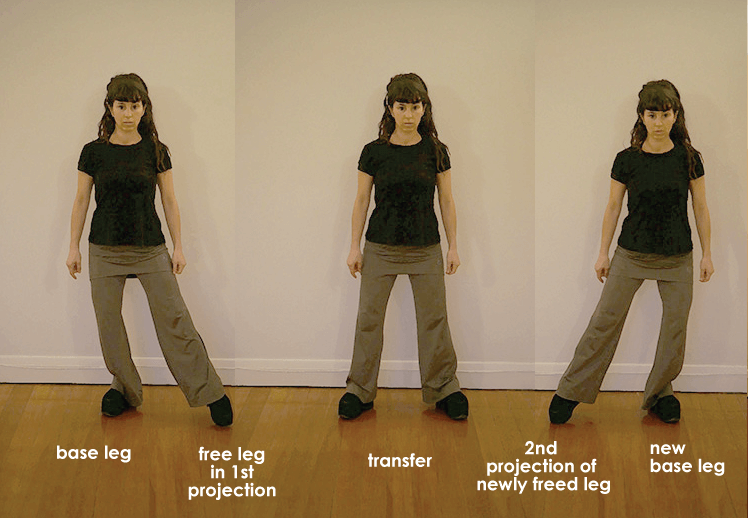
Sexy rotations
Tango has a highly stylized aesthetic which governs the rotation of the free leg during projection.
The only time we ever use internal rotation in tango is after the second projection, when the newly freed leg approaches the base leg on the way to its next projection. Only during this moment, the hip of the free leg relaxes into internal rotation and the knee and ankle relax into some flexion. As soon as the free leg passes the base and moves to extend into the next projection, it resumes external rotation and knee and ankle extension.
Don’t collect; project!
Finishing a step, the revel’s priority is to establish her new arc into the arch. Once that is done, the revel should begin to stretch her free leg into the next projection. She should never stop the motion and stretching of her body completely. Holding her body in the “collect” position makes her hard to move. If she stretches into a projection, her muscles are alive. It is never a mistake to project, because any projected direction can easily be changed by the mark without delaying the next movement. But it is a mistake to pivot before it’s marked! Here’s why.

